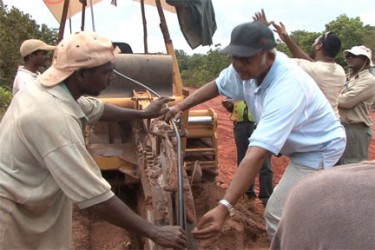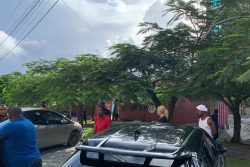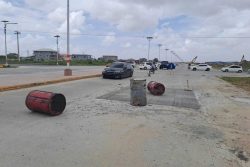Remedial works on the botched project to run a fibre optic cable from Brazil to Georgetown have begun and true to experts’ predictions it will cost about another $2 billion to fix what has already been done to the value of $1 billion.

“We have started the job about two weeks now and we are going with it …It will cost somewhere there about US$10 million,” F Mohammed , who is Chief Executive Officer of Dax Engineering , the company undertaking the rehabilitation works, told Stabroek News last Thursday, in an interview.
Head of the Presidential Secretariat Dr. Roger Luncheon, last Wednesday, disclosed that rehabilitative works have begun, when asked for an update on the project by Stabroek News.
“I am happy to say that an arrangement has been put in place to have works commence on its rehab and as I sit here, I do have some of the most initial reports of the progress being in the rehabilitative efforts by this consortium, seeking to restore the fibre optic cable to its original design and indeed its purpose, that is from transmission of bandwidth from Brazil to Castellani (House) in Georgetown,” Luncheon informed.
The project to lay a fibre-optic cable from Brazil to Georgetown, to vastly expand internet bandwidth, came back into sharp focus last December when Stabroek News reported that government officials had gone quiet on the project which had missed many deadlines.
Then at a press conference, Luncheon acknowledged that the project needed “remedial work” but failed to mention that it had been suspended. That announcement was made quietly in the December 12 edition of the Guyana Times by the Project Manager Alexei Ramotar who had not been available to Stabroek News for several weeks to discuss the state of the project.
Experts had posited that salvaging the multi-billion dollar project will be costly and will require government to be frank about key attributes of the project which may in turn expose poor decision-making.
“To salvage this project the Guyana government will have to be honest with analysts and the technical remedial team …I doubt they would want to expose the magnitude of their failures and that itself will cost taxpayers hundreds of millions more,” one fibre optic specialist had told Stabroek News.
Luncheon subsequently stated that government was engaging a consortium to finance the rehabilitation of the project.
On Wednesday, the HPS explained that he did not have the detailed information on the project at hand but assured that he would make these available.
While Mohammed explained that the project would cost about US$10 million he pointed questions as to the details of the financing and agreement to the Head of the Presidential Secretariat.
However Project Director Ramotar told this newspaper, on Friday, that taxpayers’ money would not be used in the rehabilitation exercise. “All I will say is not a cent of government money will be used,” he stated. Ramotar too said that answers about the project would come from the HPS.
The project rehabilitation contractor hopes that the project will be completed by the end of this year.
He explained that much work has to be done as past contractors “made a mess” and his company will have to now undertake a painstaking troubleshooting process to access and determine damages and plan corrective measures. “We are doing right now some corrective works and evaluation and everything to the whole stretch,” he said.
Mohammed’s company, which had undertaken some of the original work on the project, believes that past contractors did not employ skilled personnel or use the requisite machinery in laying the cables. “We invested in a brand new trenching machine and we have good Guyanese boys right here that can do the job…it is not rocket science it’s just that they did not use the rightly skilled persons,” he posited.
He pointed out that it will be more feasible to lay new cable alongside the ones that were damaged instead of digging up the old ones.
He is confident that the project will be done in promised timeframe and that it will work this time around. “Yes man, I am confident. The last time whoever [did it] brought amateurs to do professional works. We will let the professionals do it,” he stressed.
After the revelations about the project last December, city businessman and former head of the Georgetown Chamber of Commerce and Industry Clinton Urling said he was disturbed.
“It is both disturbing and disappointing to read that the fibre-optic cable component of the E-Government Project has been suspended since November 2013 due to faulty installation that now requires remedial work (GT, December 12). Why only now are we made aware of this? And who would be held accountable for the flop?” he queried.
He said the revelation by Ramotar also came as a “huge surprise” to those who had keenly followed the progress of the project.
Urling noted that in January 2014, Ramotar gave the assurance in the Guyana Times that the project was experiencing minor challenges and that “we have pushed back the handing over to August 2014. However, we expect all the parts to be finished by April 2014, we are on track for that and the April to August period is where we will be doing a lot of testing, and optimisation of the network and so forth. These are very standard things that happen in telecoms.” This assurance would have been given after the project had been suspended.
Urling said the disclosure about the project “represents a severe blow to our private sector and Guyana’s global competitiveness profile. Projects and initiatives like these should ideally be left to the private sector to undertake.
Digicel has for years expressed an interest in a fibre optic cable and it was only in October this year that the company was informed that its application for a submarine cable was approved.
“Government should only intervene if a gap or vacuum exists. And if the government does commit to such projects, hire professionals with the requisite competence and experience to successfully execute the job,” Urling said.
The E-Governance project and the fibre-optic cable project have been described by the government as separate projects. The E-Government Project aims to provide the necessary Information and Com-munication Technology so that government can provide better service to all Guyanese.
It encompasses the setting up of a fibre link between Moleson Creek, Corentyne; Georgetown; Parika, East Bank Essequibo and a fibre ring within Georgetown. A high speed microwave link will also be set up between Linden and Georgetown and will serve as a back up to the fibre network.
This microwave network will be managed from the data centre in Georgetown which will serve as the repository for government information.
The project was to be completed in April 2014 but this was extended to August 2014 for a number of technical changes. This included switching from WiMax and EVDO networks to an LTE-Advanced network. However, none of the deadlines have been met.
Experts in the field had argued that the lack of experience of the Project Coordinator had led to the many missed deadlines. One expert speaking to Stabroek News stated that running a continuous cable on the ground was bound to have severe problems from the inception however when this criticism was ventilated it was ignored by those in authority.
It had been noted since then that damage to the cable at any one point would render it useless and having it buried, poorly at that, along the roadside left the fibre optic cable exposed to problems such as erosion.
The project, which includes the laying of the fibre optic cable from Brazil, commenced in January 2011 and was supposed to be completed in 2012.








